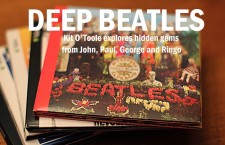During the height of Beatlemania, the group’s hectic schedule involved touring, taping radio and television appearances, filming A Hard Day’s Night, and, of course, virtually constantly recording singles and albums.
In August 1964, EMI informed George Martin and the Beatles that they needed Christmas product in order to fulfill every teenager’s dream of seeing a new album under the tree. Thus, the group squeezed in sessions, pulling together a conglomeration of originals and covers. One such song, a relic from their Hamburg and Liverpool days, was recorded but failed to appear on what would become Beatles for Sale: “Leave My Kitten Alone,” long considered one of the “long lost” Beatles tracks until its official release as part of Anthology 1.
First recorded by “Fever” singer Little Willie John in 1959, “Leave My Kitten Alone” represents a cross between R&B and classic ’50s rock. Perhaps lessening any overtly sexual connotations, the background singers provide “meows” every time Little Willie John sings the title phrase. The sax solo recalls the strident sound of “Yakety Yak” by the Coasters, which was released just a year before “Kitten.”
“Running Bear” singer Johnny Preston’s subsequent 1961 remake retains the “meow” backing vocals and the saxophone solo. According to Mark Lewisohn’s Tune In, John Lennon and Paul McCartney discovered the Little Willie John version when it was first released; by 1961, the Beatles added the song to their setlist. They drew their arrangement from one or both of these singles, but eliminated the backing vocals and saxophone solo, leaning heavily on the song’s rock and blues roots.
When the Beatles entered Abbey Road Studios on August 14, 1964, they began work on three songs: “I’m a Loser,” “Mr. Moonlight,” and “Leave My Kitten Alone.” After completing the first two tracks, the Beatles turned to a song they had not performed live in two years. As McCartney told Mark Lewisohn in the Complete Beatles Recording Sessions, it “was a Johnny Preston song that we’d rehearsed in Liverpool along with all our Cavern stuff and it was just in our repertoire. It wasn’t a big one that we used to do, we’d pull it out of the hat occasionally.”
Under Martin’s direction — with Norman Smith serving as engineer — the Beatles recorded five takes, the fifth deemed best. Next, Lennon overdubbed a second lead vocal, with Harrison double tracking his lead guitar. Finally, McCartney added a piano section, and Starr contributed additional tambourine parts. According to Kenneth Womack’s Martin biography Maximum Volume, this original version ends abruptly; Martin most likely intended to insert a fadeout in a future mixing session. For reasons never made clear, both Martin and the Beatles elected to shelve the track.
While the excessive double-tracking of John Lennon’s lead vocals somewhat mutes the power of his singing, “Leave My Kitten Alone” showcases his ability to make a song his own. Little Willie John and Preston’s previous renditions created a somewhat lighthearted tone, a “winking” quality (underscored by the female backup singers) that made the tune inoffensive. In Lennon’s hands, however, the song transforms into a menacing tone, a rasp entering his voice as he virtually shouts the lines “Well Mr. Dog, I’m gonna hit you on the top of your head / That child is gonna miss you, you gonna wish that you was dead.”
Featuring a snarling guitar solo from Harrison, “Leave My Kitten Alone” leaves little room for doubt that the narrator intends to carry out his threat if the “big bad bulldog” ever nears his woman again. The Beatles’ rocking makeover lends a sinister tone to the lyrics: One can picture the group ripping into this track at the Cavern, sending audiences into a frenzy.
“Leave My Kitten Alone” almost received an official release in 1985, when Geoff Emerick remixed it for the planned Sessions compilation. (Two years before, engineer John Barrett had discovered the tapes in an Abbey Road vault and remixed “Leave My Kitten Alone,” as well as other lost songs for a public studio tour.) When the Anthology documentary project finally came to fruition, George Martin revived the track. According to Richie Unterberger’s The Unreleased Beatles: Music and Film, Emerick mixed Lennon’s lead vocals down to better balance with the instruments at Martin’s request.
Why was “Leave My Kitten Alone” eliminated from Beatles for Sale? Fans debate the question to this day.
Lewisohn raises the issue in The Complete Beatles Recording Sessions, suggesting that the track could have replaced the controversial “Mr. Moonlight.” Perhaps the raw sound of “Leave My Kitten Alone” competed too much with the likes of other album tracks such as “Rock and Roll Music” and “Kansas City/Hey, Hey, Hey, Hey.” Ian MacDonald posits another theory in Revolution in the Head: “Everybody’s Trying to Be My Baby” replaced “Leave My Kitten Alone” in order to give Harrison a lead vocal track. The reason for the decision remains shrouded in mystery.
In a 1989 Los Angeles Times interview, McCartney teased fans that the track would soon surface as part of a Beatles documentary the titled The Long and Winding Road, calling the song “the top thing of the unreleased stuff.” That documentary eventually became Anthology, with “Leave My Kitten Alone” finally seeing official release on 1995’s Anthology 1 companion album.
For years, audiences had heard about the track containing the astounding John Lennon vocal; at last, “Kitten” could be appreciated in pristine audio. It may have languished for more than 30 years, but “Leave My Kitten Alone” demonstrated how the Beatles could reshape songs to fit their new, harder-rocking and uniquely youthful sound.
- The Rescued Early Paul McCartney Song That Completed ‘Beatles For Sale’ - December 4, 2024
- A Rare Beatles Cover Proves John Lennon Was Wrong About His Voice - November 26, 2024
- How John Lennon Came Roaring Back on the Beatles’ White Album - November 22, 2023


